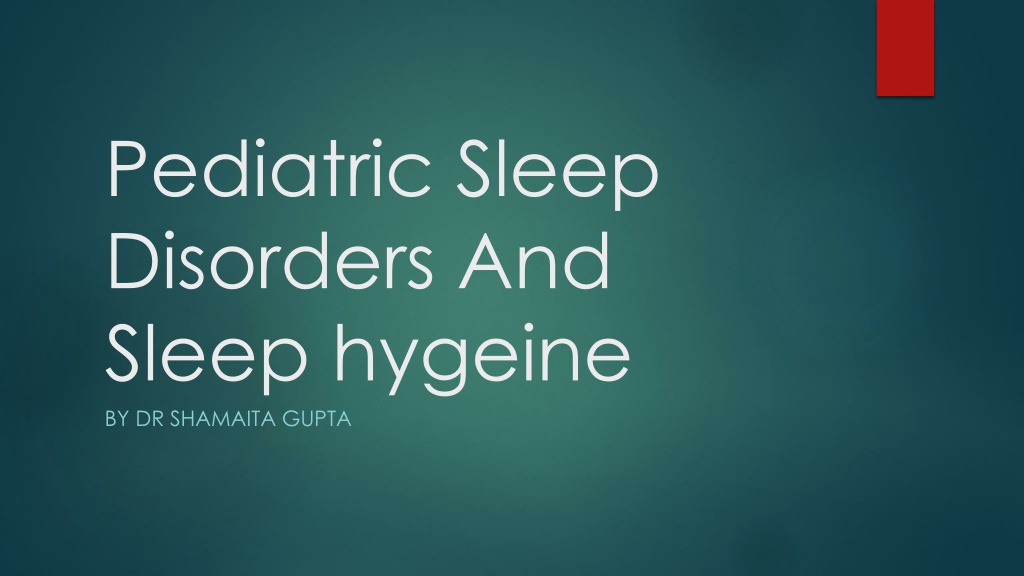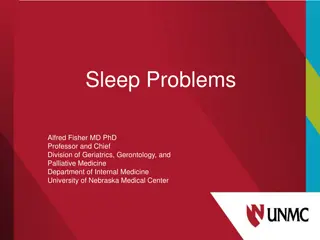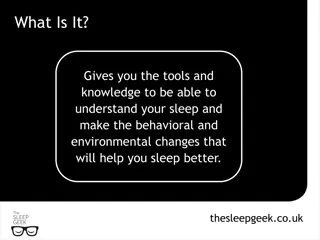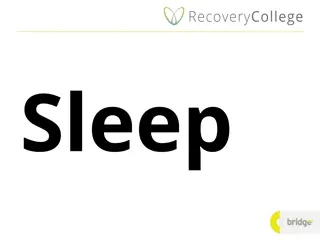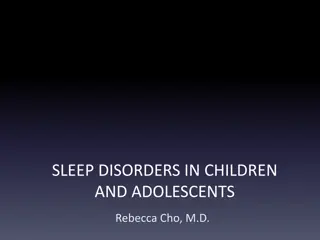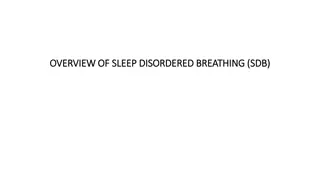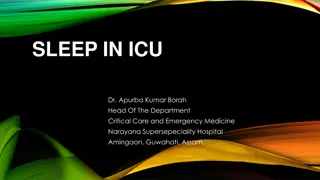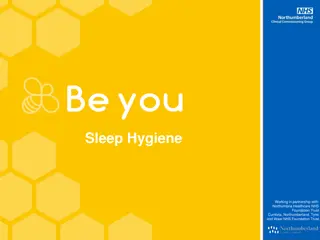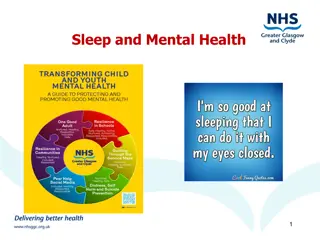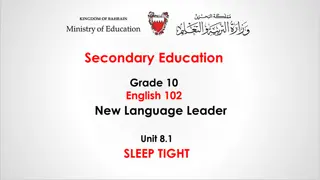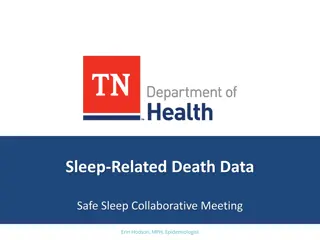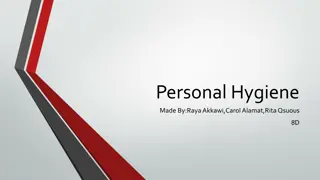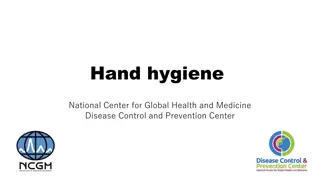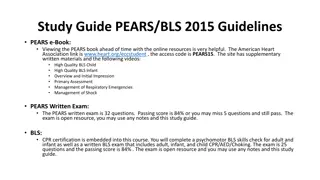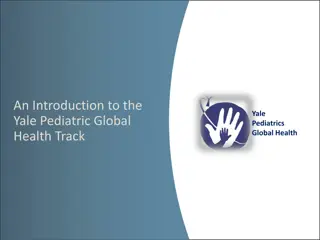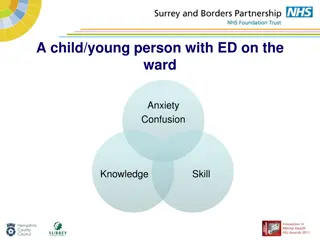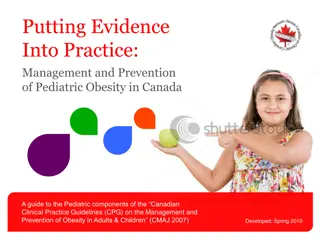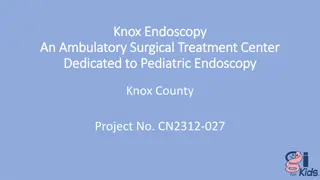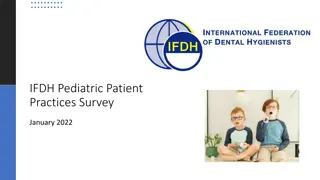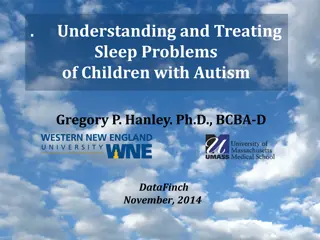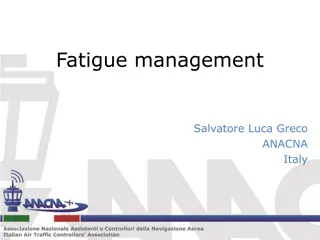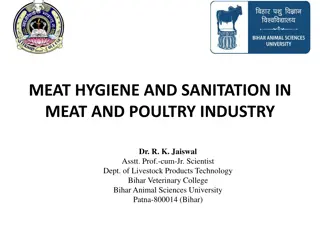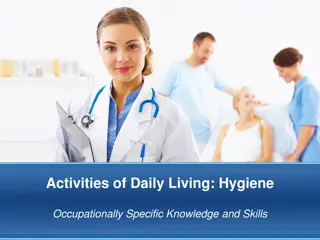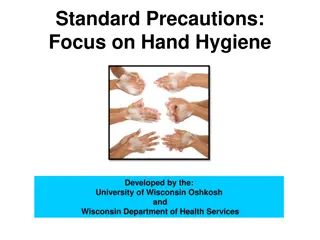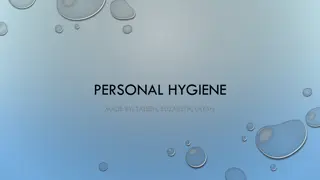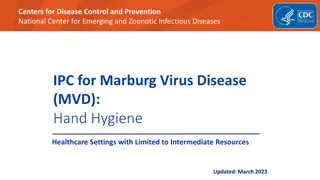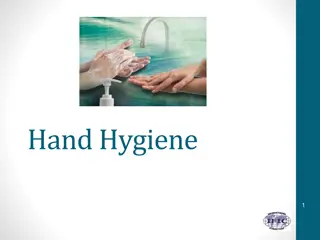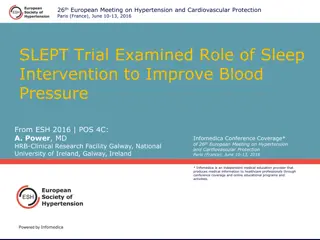Pediatric Sleep Disorders and Sleep Hygiene Overview
Understanding normal sleep patterns in children, common pediatric sleep disorders, and treatment options. Exploring the sleep cycle, duration of sleep cycles, sleep regulation, changing trends in sleep patterns, and prevalence of pediatric sleep disorders impacting daily functioning.
Download Presentation

Please find below an Image/Link to download the presentation.
The content on the website is provided AS IS for your information and personal use only. It may not be sold, licensed, or shared on other websites without obtaining consent from the author. Download presentation by click this link. If you encounter any issues during the download, it is possible that the publisher has removed the file from their server.
E N D
Presentation Transcript
Pediatric Sleep Disorders And Sleep hygeine BY DR SHAMAITA GUPTA
Objectives Understand normal sleep in children Review common pediatric sleep disorders Discuss proper treatment options for childhood sleep disorders
The sleep cycle Each sleep cycle 90 120 minutes First REM period is shortest Most NREM deep sleep occurs early Most REM occurs late
Sleep Regulation Regulated by the combined action of two processes. The homeostatic process( Process S) - Rise of sleep pressure during wakefulness and its dissipation during sleep due to accumulation of adenosine and other sleep promoting somnogens during prolonged wakefulness The second process refers to circadian oscillations(Process C), which superimpose a nearly 24-h pattern on the sleep-wake cycle: by actively promoting wakefulness during the biological day and sleep during the biological night,i.e., during phases of melatonin secretion by the pineal gland. This rhythm is triggered and adjusted to the external light-dark cycle by external inputs like light(called zeitgebers) to the brain s main circadian pacemaker, the suprachiasmatic nuclei (SCN) of the anterior hypothalamus.
The changing trends of sleep patterns Newborn - up to 18 hours 1 12 months - 14 18 hours 1 3 years -12 15 hours 3 5 years - 11 13 hours 5 12 years - 9 11 hours Adolescents - 9-10 hours The REM sleep time decreases from birth(50%) to early childhood to adulthood(25-30%) Irregularities of sleep patterns start in early childhood depending on school night and non school night bed times
Pediatric sleep disorders prevalence 25% - 43%of children ages 1-5 years interferewith daily patient and family functioning. sleep problems cause significant emotional, behavioral, and cognitive dysfunction. common among children with medical, neurodevelopmental and psychiatric disorders
Most common causes of sleep abnormality: Inadequate duration(insufficient quantity) Difficulty in initiating Difficulty in maintaining sleep Disrupted or fragmented sleep(poor quality) Less common causes of sleep abnormality Inappropriate timing of sleep Cicardian rhythm disturbances Excessive day time sleepiness
DSM-V classification 1- Dyssomnias (# duration, timing of sleep) Primary Insomnia Primary Hypersomnia Breathing-Related Sleep Disorder Narcolepsy Circadian Rhythm Sleep Disorder 2- Parasomnias (abnormal events during sleep) Nightmare NightTerrors Sleep walking 3- Medical and Psychiatric disorders
The clinical evaluation involves: obtaining a careful medical history assess for medical cause of sleep disturbance Current sleep patterns, including sleep duration, sleep-wake schedule, sleep habits, Nocturnal symptoms Polysomnogram (PSG) record:EEG, EMG, EOG, Vital Signs and Other Physiologic Parameters
Insomnia Difficult initiate or maintain sleep or early morning awake with difficult return to sleep Occur 3 nights/week, for at least 3 months, despite sufficient time for sleep. Not due to the effects of a substance Not explained by mental/medical illness Prevalence 1 6 % in pediatrics but higher in children with chronic med/psych conditions
Treatment of Insomnia Mainly treated with behavioral interventions Media removal from bedroom Avoid caffeine Consistent bedtime routine and positive reinforcement from parents/caregivers Correct the underlying med/psycho factors
Beavioral therapy(graduated extinction) More commonly in infants and toddlers the problem stems from learning to fall asleep only under certain conditions that require the parent to intervene For example, child must be rocked or fed to fall asleep Child does not learn to self- soothe during normal brief arousals between sleep cycles In pre-school age and older children, the problem is active resistance to bedtime rather than prolonged wakings during the night Systematic ignoring or extinction (Unmodified version is known as crying it out ) has been documented to be a highly successful treatment, but difficult for parents to adhere to . Alternative is to do this more gradually, with longer periods between checking on child. Keep contact brief and avoid picking child up
Contd.. Also Known as Ferber Method The child is allowed to cry for sometime before intervention is done by the parents The time of intervention is gradually increased. The child is taught to calm itself and fall asleep on its on Sometimes a visit for a few minutes and a small pat on the bag is given Slowly the crying time slowly decreases and the baby falls off to sleep on its own by 3-4days of extinction However this method is criticised to be emotionally exhausting for both parents and the child.
Hypersomnolence disorders prolonged sleep episodes, excessive sleepiness prolonged sleep > 9 h/day that is not refreshing Difficulty being fully awake after abrupt awakening The complaint is present for at least 6 months. Not due to med/psycho disorder Common in in late adolescence.
Sleep disordered breathing Obstructive Sleep Apnea (1 4%) Results in blood oxygen desaturations Upper Airway Resistance Syndrome Similar to OSA but not result in desaturations Primary Snoring (7 12%) regular snoring without changes in sleep architecture, alveolar ventilation or oxygenation
Obstructive sleep apnea Periodic apneas due to sleep-related airway obstruction patency (obstruction and/or diameter) collapsibility ( pharyngeal muscle tone) drive to breath ( central ventilatory drive) Not all snorers have OSA
Sequelae of OSA Disrupt ventilation and sleep patterns intermittent hypoxia and multiple arousals cause significant metabolic, CVS, neurocog/behavioral and academic morbidity Daytime Sleepiness, Enuresis as short-term squeal Pulmonary hypertension and right heart failure, FFT as long term sequel
Treatment of Sleep Apnoea Weight loss Positional (sleep on one side or prone) CPAP prevents obstruction by soft-tissue and keeps airway open Surgical intervention (e.g., tonsiloadenectomy) Avoid sedatives (which prevent reawakening to breath)
Narcolepsy uncontrollable excessive daytime sleep attacks interfere with normal daily functioning Person goes directly into REM sleep Common in adolescence & early adulthood Genetic defect in hypothalamic orexin/hypocretin neurotransmitter prevalence is 3-16/10,000
Narcolepsy symptoms Cataplexy (pathognomonic for narcolepsy) Abrupt bilateral partial or complete loss of m. tone. triggered by intense positive emotion (e.g., laught) last for seconds to minutes with complete recovery Hallucinations (visual, auditory,tactile) occur during transitions bet. sleep and wakefulness At sleep onset hypnogogic Atsleep offset hypnopompic Sleep paralysis: inability to move or speak for sec- min at sleep onset or offset; accompanies hallucination
Contd.. DD Potential causes of EDS: Extrinsic:Secondary to insufficient/fragmented sleep Intrinsic:CNS disorder with need for sleep. Treatment include: Education, good sleep hygiene, behavioral changes (eg. Scheduled naps). Medications as: psychostimulants and modafinil to control EDS. TAD and SSRI to control REM-associated phenomena, such as cataplexy
Cicardian rhythm disorder Circadian Rhythm Sleep Disorder caused by mismatch between sleep-wake schedule required by a person s environment and his/her circadian sleep-wake pattern.
Delayed sleep phase syndrome It is a circadian rhythmdisorder significant, persistent, intractable phase shift in sleep wake schedule (later sleep onset and waketime) Patients has inability to get to sleep until the early morning, but little difficulty sleeping once asleep Interfere with school, work and lifestyledemands. Common in adolescents and young adults (7-16%)
Treatment Treatment is primarily behavioral Shifting the sleep-wake schedule to an earliertime Maintaining the new schedule. Gradual shifting bedtime/wake time earlier by 15- 30 min increments Exposure to light in morning and avoidance of evening light exposure Oral melatonin supplementation in the afternoon or early evening is effective in advancing the sleepphase.
Sleep related movement disorder Restless leg syndrome: Uncomfortable sensations in the LL accompanied by irresistible urge to move legs Disturbssleep Often mistaken as growing pains. Relieved only by movement only to recur on stopping movement Periodic limb movement disorder: periodic, repetitive, brief (0.5-10 sec) highly stereotyped limb jerks (rhythmic extension of big toe and dorsiflexion at ankle) Disruptssleep. Prevalence in children is 8-12%. Diagnosis of PLMs requires overnight polysomnography . Treated according to severity (intensity, frequency, periodicity(<5/hour or more)) , degree of sleep disturbance, daytime sequelae. Sleep related rhythmic movements: repetitive, stereotyped, rhythmic movements involve large muscle groups. Like head banging, body rocking etc. may be seen in transition while going off to sleep. Treatment is reassurance to parents.
Pediatric parasomnias Episodic nocturnal behaviors involve cognitive disorientation and autonomic and skeletal muscle disturbance.
Prevalence of parasomnias in pediatric age group 80% 70% 60% 50% 40% 30% 20% 10% 0% Any sleep sleep night RLS nocturnal bruxism walking talking terror enuresis
Persistence of childhood parasomnias into adulthood Enuresis SleepTerrors Bruxism Sleepwalking 0 5 10 15 20 25 35
Nightmare Sleep disorder characterized by high arousal and appearance of being terrified 2/3 of all kids experience them Common in preschoolers ages 3-6 y Occur during REM sleep Child believes them to be real.
Night terror repeated abrupt awakenings from sleep characterized by intense fear, panicky screams, autonomic symptoms (tachycardia, rapid breathing, sweating), absence of detailed dream recall, amnesia for the episode, and relative unresponsiveness to attempts to comfort the person. Lasts ~ 10 min then returns to undisturbed sleep During Stage 3-4 of NREM sleep (1st third of night) Prevalence is 3 6.5% in children. can occur at any age. Common in male resolves spontaneously Nocturnal administration of benzodiazepines has been reported to be beneficial
Bruxism involuntary, forceful grinding of teeth during sleep Up to 88% of children; 20 % of adults Any stage of sleep May result in damage to the teeth Periodicity of 20 to 30 seconds. May represent symptom different disorders Patient is usually unaware of the problem In severe cases, rubber tooth guard is necessary. Stress management or biofeedback.
Sleep talking Begins during school age During NREM and REM sleep No treatment just reassurance Night wakening One or more waking from midnight to 5 am for at least four of seven nights per week for at least four consecutive weeks
Sleep walking More than just walking around Simple Behaviors and Complex Behaviors While sleepwalking, patient has a blank staring face, unresponsive to others. confused or disoriented on being aroused. relatively Complete amnesia Occur during Stage 3-4 Sleep; 1st third of night. Begins in ages 4-8 yrs. 17% in children (4% of adults) sleep-walking most likely to persist it is important to institute safety precautions (use of gates, locking doors and windows, and bedroom door alarms). No treatment is established, but may respond to benzodiazepines or sedating antidepressants at bedtime.
Non REM confusional arousal parasomnia Usually during first 1/3 of night Usually only one event/night Common in Toddler and school-aged kids. prevalence rates 15% in children ages 3-13 yr. co-occur with sleepwalking and sleep terrors Usually resolve with time Not tired the next day No stereotypic motor movements Last 5-30 minutes
Treatment of Parasomnias parent education and reassurance good sleep hygiene avoidance of exacerbating factors such as sleep deprivation and caffeine. Scheduled awakenings, parent wake the child 15 to 30 min before the time of first parasomnia episode. Pharmacotherapy is rarely necessary, include benzodiazepines and tricyclic antidepressants.
Sleep hygiene for toddlers Make sure the baby is not hungry when you put him to bed. Feed the baby right before bedtime so he or she is not hungry when put to bed. Place the child in bed when he is sleepy but not yet asleep. Make sure your child is still awake when he is put down for naps and at bedtime. Placing the baby in bed while he is still awake lets him learn to fall asleep on his own. Place the child on his back when putting him to bed, up to one year of age . Have a nighttime routine and a regular sleep schedule. Set a bedtime for te child. Be sure to stick with the time selected by putting the baby to bed at the same time every night. Start a nighttime routine that includes feeding, bath, bedtime story, etc. Do not let the child nap for too long or too late in the day. Try to limit naps to no more than 3 hours. Also, make sure the child is awake from the afternoon nap by 4 pm. Children who sleep later than 4 pm may not be ready to go back to sleep when it is their bedtime. Do not put the child in bed with a bottle or cup. Sleeping with milk or juice in the mouth can lead to cavities and tooth decay.
Sleep hygiene for children Have a set bedtime and bedtime routine Bedtime and wake-up time should be the same time on school & non-school nights. No more than 1hour difference from one day to another. Make the hour before sleep quiet time. Avoid high-energy activities before bed.
Contd Don't put the child to bed hungry, but avoid Heavy meals. spend time outside every day and involve in regular exercise. Keep bedroom quiet and dark with comfortable temperature Don't use bedroom for punishment Naps should be short (no > 1hr) and scheduled in the early to midafternoon. Keep TV out of child's bedroom. Use bed for sleeping only. Don't study, read, watch TV on bed. Relaxing, calm, enjoyable activities help you to get to sleep.
Sleep hygiene for adolescents Budgeting eight hours of sleep into your daily schedule and keeping that same schedule on both weekdays and weekends. Creating a consistent pre-bed routine to help with relaxation and falling asleep fast. Avoiding caffeine and energy drinks, especially in the afternoon and evening. Putting away electronic devices for at least a half-hour before bed and keeping them on silent mode to avoid checking them during the night.
Contd.. Setting up your bed with a supportive mattress and pillows. Keeping your bedroom cool, dark, and quiet. Smoking and alcohol disturbs sleep Use bed only for sleep Regular exercise Regular meals before going off to sleep. Avoid catch up sleep in weekends. Do not use sleeping pills
